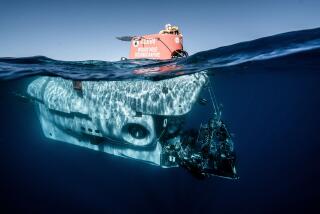Robot Sub Turns Science Fiction Into Science Fact
FALMOUTH, Mass. — Scientists at the Woods Hole Oceanographic Institution have stenciled the number NCC-1701 on their new $1-million robot submarine, the same designation as the starship Enterprise.
Not only does the sub look like the spaceship from the television series “Star Trek,” it is also the first of its kind. It’s meant to go where no one has gone before: to the bottom of the deepest oceans.
The robot sub recently made its first successful dive in Falmouth Harbor. Now engineers are preparing it for sea trials; no date has been set.
“We’ve got a whole unexplored ecosystem down there,” said Albert M. Bradley, one of the creators of the Autonomous Benthic Explorer, or ABE. “It’s so difficult to get down there, and if you bring things up, they die.”
Bradley struggled on the dock recently with adjustments to his 6-foot-long submersible, which consists of a white torpedo-like stabilizer and instrument canister suspended by struts from two red tubes.
It can be lowered to a depth of 6,000 meters, deeper than the manned submarine Alvin and the tethered submersible Jason Jr., which both explored the wreck of the Titanic. And it can stay underwater for as long as one year, continually studying the ocean floor until a research ship retrieves it.
Also unlike its predecessors, ABE needs only two scientists to program and maintain it; Alvin needs 20, Jason 12.
The bottom line is that ABE is cheaper to operate than Alvin or Jason, which can cost up to $25,000 a day to operate.
“As a world economy, we can’t afford a lot of Alvins,” Bradley said.
The advance comes as oceanographers are intensifying their study of the deepest sections of the ocean, where ultra-hot vents on the sea floor spew water at a temperature of up to 660 degrees, depositing mineral formations full of cobalt, copper, iron, gold, manganese and silver.
The vents, discovered in 1977 by Woods Hole geologist Robert Ballard, are also rich in enzymes used as tools in biomedical procedures such as gene splicing. The enzymes are in demand because of their tolerance to the vast temperature variations used in the process.
“To fully understand how these hydrothermal fields operate, we need to monitor them over time,” said Charles H. Langmuir of the Lamont-Doherty Earth Observatory at Columbia University. “The new vent field has sparked enormous interest in establishing a natural laboratory in the Atlantic to study vent phenomena.”
Communities of sea life at extreme depths are chemically powered by sulfides, making them the only life on Earth not powered by the sun. The temperature is so hot, the water seems to glow.
ABE can latch onto a mooring dropped by a support ship, and continually monitor an area of ocean floor the size of a football field, cruising back and forth lawnmower-style and taking pictures with its three digital cameras.
Bradley sees other uses for his relatively inexpensive robot sub.
There are an estimated 75 sunken nuclear warheads and reactors in the ocean, for example, and “if one does start to leak, we damn well better know about it,” he said. “We can’t afford to recover all of them, so what do we do? We watch them and recover the ones that leak.”
Its inventors are wary about predicting other breakthroughs.
“We’ve got to guard against sounding flaky,” Bradley said.
But he says enzymes collected from the undersea vents could accomplish things once dreamed about in science fiction, such as creating a bacteria that would distill gasoline from lawn clippings.
“Science fiction is dead serious,” Bradley said. “A good author does his best to model reality, changes something and says, ‘What would happen then?’ All the futurists read science fiction.”






